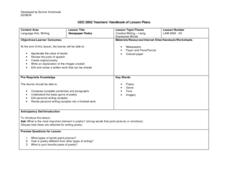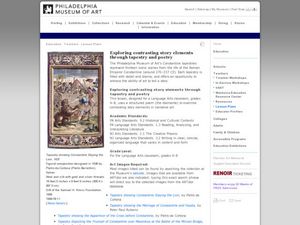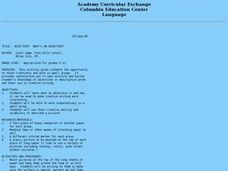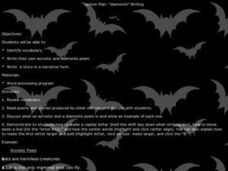Novelinks
The Hobbit: Biopoem
As part of their reading of The Hobbit, readers create a biopoem for one of Tolkien's characters.
Curated OER
Writing
Young scholars practice word processing skills while writing Haiku and diamonte poems. In this poetry computer lesson, students choose from a group of rainforest animals and write about their animal. Young scholars write a narrative...
Curated OER
Making Poetry Writing Fun!
Young scholars find a group of words from an unlikely source and turn them into a poem. They discuss the central image in two well-known poems by Langston Hughes and Emily Dickinson. They write their own short poem expressing one...
Curated OER
Newspaper Poetry
High schoolers cut out nouns, verbs, adjectives, and adverbs from newspapers and create poems using words they have found.
Curated OER
A Journey To Japan Through Poetry
Third graders gain an appreciation for writing, analyzing, reading and listening to poetry, viewing poems as a motivation for studying Japanese culture and tradition. They study and create their own haiku and tanka poems with illustrations.
Alabama Learning Exchange
Landforms Acrostic Poetry
Fourth graders apply scientific information about various landforms. They use the information to write and word process acrostic poems which they illustrate with clip art or pictures from magazines.
Curated OER
Poetry Alive! Interpreting Poetry Using Digital Images
Students investigate poetry by incorporating images into the words of a poem. In this language arts lesson, students discuss poetry writing devices and self expression with their classmates. Students create a film about the poem by...
Crafting Freedom
George Moses Horton: Slavery from a Poet's Perspective
Pupils have the unique opportunity to learn about the institution of slavery by reading first-hand experiences as described by George Moses Horton, the first slave to publish anti-slavery poetry.
EngageNY
Writing Interview Questions
And now for the star witness! Scholars take a look at a model newspaper article and discuss the importance of eyewitness accounts. In groups of three, they take turns underlining text from eyewitnesses. They then regroup to talk about...
Curated OER
Ballad
Young balladeers analyze examples of ballads and generate a list of common traits (story, quatrains, rhyme schemes, refrains, etc.), then identify these traits in Robert W. Service's "The Cremation of Sam McGee" and a ballad written by...
K20 LEARN
The New Colossus: Determining Author's Perspective
Introduce young scholars to the concept of the author's perspective with a lesson that uses Emma Lazarus's poem, "The New Colossus," as the anchor text. Groups use a T-chart to identify words that reveal the author's point of view of The...
Curated OER
Response to Literature: Anecdotal and Saga Memoir Poems
Students differentiate between anecdotal and saga memoir poems. In this response to literature lesson plan students analyze poems written by others then analyze incidents from their own lives to determine whether they meet the criteria...
Curated OER
Poetry--Homeless People
Eighth graders create a poem about homeless people using images they saw on websites. After reading the book "The Outsiders", 8th graders make connections of real life homeless people with characters in the book. Students search the web...
Curated OER
Lesson Plan 3: Great Book, Gross Book
It's time for your scholars to become book reviewers! Start with a fun review of foods: are they good or gross? Learners apply these evaluation techniques to books, recording their thoughts on large pieces of butcher paper. Simply have...
Curated OER
Prairie Poetry
Ninth graders take note of the ways in which word choice, rhythm, language and narrative voice, as well as point of view in a poem can be used to evoke a time and place. They use their insights to create a poem of their own.
Curated OER
Pinhole Photo Narratives
Students create original pieces of poetry and use this as a basis for a photography series using "pin-hole camera" techniques. This high school lesson plan is cross-curricular in scope.
Curated OER
Exploring Contrasting Story Elements Through Tapestry and Poetry
Young thinkers view two narrative art tapestries and study the images included that tell a story about the Roman Emperor Constantine. As they examine the details of the tapestries, pupils use a Venn Diagram to record the similarities and...
Curated OER
Analyzing Poetry with TPCASTT
Middle schoolers read a poem and complete a TPCASTT chart. They make a prediction about the title (T) , paraphrase each line (P), identify poetic devices and nuances (C-connotation), explore mood and tone (A-attitude), point out shifts...
Curated OER
Use of Personification and Imagery in Poetry
A reading of Theodore Roethke’s dark "Root Cellar" and Sylvia Plath’s more abstract "Mirror" launches a discussion of imagery and personification in poetry. After finding examples of personification in the poems, class members craft...
Curated OER
Natural Disasters: Stormy Weather in Art, Writing, and Music
Using personal experience, visual art, and music that evoke natural disasters, your older high schoolers create their own expressions of storms. Learners conduct online research about weather drama. They make their own expressive...
Curated OER
Transforming Negatives to Positives
Students write diamonte poems that correspond to the double-exposed photograph they created. In this poetry and multimedia artwork lesson, students use the photographic process to create a double-exposed photo then create a diamonte...
Digital Public Library of America
Teaching Guide: Exploring Little Women
Louisa May Alcott's Little Women is a literary masterpiece as well as a timestamp of the formative mid-nineteenth century in America. Using a primary source set of photographs, letters, and portraits, readers discuss the ways...
Curated OER
Adjective? What's an Adjective?
Mount a variety of pictures (fantasy, rustic, portraits, action) on large sheets of paper and post them around the classroom. Groups rotate from poster to poster, adding adjectives to describe each of the pictures. Writers use these word...
Curated OER
Diamonte Writing
Students discover poetry while practicing their storytelling skills. For this language arts lesson, students read diamonte and acrostic poems written by other students on the Internet. Students create their own narrative stories about...

























